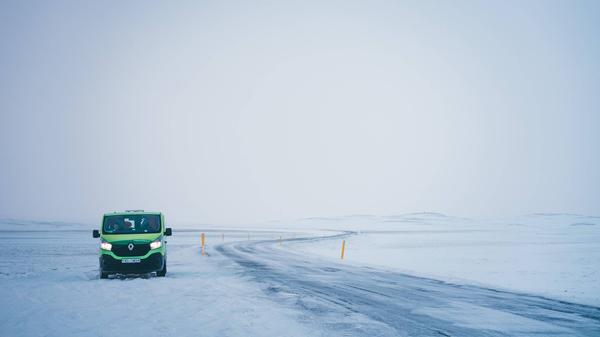Advice
Winter Van Driving And Care Tips
Weather conditions can swiftly change in the UK and being prepared for the more challenging winter weather is important. Read on for Auto Trader’s top winter van driving and care tips.


Words by: Tom Roberts
Published on 31 October 2023 | 0 min read
Weather conditions can swiftly change in the UK and being prepared for the more challenging winter weather is important. Read on for Auto Trader’s top winter van driving and care tips.
For van drivers, especially those tradespeople who need to reach customers in adverse conditions, driving in snow, ice and sleet will be a necessity. Fortunately, with some preparation and planning, you can make winter driving more manageable for you and your van.
Winter Essentials To Carry In Your Van
If you’re going to be travelling in the snow and ice, whether it is a few short journeys or a long journey, it’s always better to be safe than sorry when it comes to supplies.
Here’s a few must-haves to throw into the back of your van during winter:
Here’s a few must-haves to throw into the back of your van during winter:
- Ice scraper and de-icer.
- A shovel, just in case you need to dig your wheels out of the snow.
- Old carpet or rags to place under your van wheels and prevent them skidding if they get stuck in place.
- A blanket to wrap yourself up in if you must wait in the van for help.
- Some cold-weather gear in case you must walk to seek assistance or find an emergency phone.
- First aid kit. FYI, if you’re a tradesperson, you should already have one in your van.
- Some food, maybe a warm drink in a flask, just in case you're stranded for a few hours – there’s nothing worse than being cold AND hungry.
- And finally, a flashlight, functioning batteries, mobile phone charger, jump leads and a tow rope.
Prepare Your Van For Winter Driving
If you’re going to be driving your van around in the winter weather, it's crucial your van is safe for driving in those conditions. Here are some checks to make:
- Keep your tyres at the correct pressure because cold weather can cause tyres to lose air and make it more difficult to drive in bad conditions.
- Check your tyre tread depths are at least 3mm all around the vehicle, this is twice the legal minimum and will give you some good grip – you might also consider switching to winter tyres.
- Look at the condition of your van's battery because low temperatures will affect its ability to hold charge, especially if it’s already in bad condition. Local garages often run free winter battery checks, so take advantage of one if you think your battery might need replacing.
- Stock up on windshield washer fluid that have anti-freezing agents in them and keep a bottle in the back of the van – grit and fluids on the roads mean dirtier windscreens.
- Check that your windshield wipers are up to scratch, as they’ll be working harder in the winter.
- Check your van’s levels of engine coolant and antifreeze are above the vehicle’s mandatory minimums to prevent damage.
- If possible, park your van under cover to reduce the impact of frost, ice and snow.
- Your deadbolts and locks might freeze, so get yourself some lock de-icer or (and this is a great tip) warm up your key before gently inserting it into a frozen lock.
How To Drive A Van In Snow And Ice
When heading out for a job in snowy or icy conditions, the easiest tip is to allow extra time for your journey and stick to main routes that are more likely to be gritted – country roads are often ignored by gritting routes and are often unlit.
So, here are some tips for safe winter van driving:
So, here are some tips for safe winter van driving:
- Go slow and safe – gentle manoeuvres can prevent wheel skidding and keep you in control of your van.
- Begin in second gear – not first gear – to avoid wheel spin. It’s worth staying in a higher gear as you get moving to prevent over-revving the engine.
- Stopping distances are longer as weather conditions get worse, so reduce your speed gradually and keep a safe following distance between you and other vehicles.
- If you start to skid, best thing to do is steer into the skid, don’t brake and push the clutch down – hopefully, you’ll get grip back and be able to wrestle the vehicle under control.
- If you’re driving uphill, select a gear that lets you maintain a steady speed and just keep going – avoid stopping midway otherwise you’re just going to slide back down.
- When traveling downhill, use a low gear to give yourself some traction and try not to brake so much to prevent skidding. Apply the brakes gently if you must use them.
What To Do If You Get Stuck In Snow
If your van gets stuck in the snow, try digging the wheels out of the snow and placing an old carpet under your wheels and slowly accelerating onto it to free yourself. Once free, don’t stop again if you can help it.
If you end up having to wait for rescue, take in your surroundings and stay in your van if it's safer to do so. Handy thing is, if you've followed the checklist above, you should have everything you need to survive the elements while you wait for help.
If you end up having to wait for rescue, take in your surroundings and stay in your van if it's safer to do so. Handy thing is, if you've followed the checklist above, you should have everything you need to survive the elements while you wait for help.